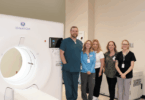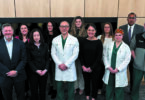Improving the patient experience is always top-of-mind for UHS employees. It gets to the heart of UHS’ mission to provide patients with “Your care. Your way.” For the past two years, the providers and staff at UHS Primary Care Greene have taken this goal to heart by working on a patient-centered, team-based care model to improve their practice.
Through this model, the practice looked at better coordinating patient care to ultimately give their patients better access to care. Rethinking their plan and launching a team-based approach has not only helped the staff provide better care, but also greatly improved patient satisfaction and experience.
“We identified gaps in care with the goal of answering the question: How can we best meet the needs of our patients and give them a consistent experience?” says Martin Masarech, MD, family physician at UHS Primary Care Greene, who is known as “Doc” around the office. “We looked at all levels of the organization and tried to empower employees so they could use their skills most efficiently and perform at the best level.”
Sarah Singlar, NP, nurse practitioner at UHS Primary Care Greene, says an important part of making this successful was keeping everyone in the loop.
“We have a full staff meeting monthly and meetings throughout the month where we bounce things off each other,” she says. “Clinical and front-end staff all give their input, and it works well.”

Martin Masarech, MD, family physician at UHS Primary Care Greene, has been with UHS for 33 years. Recently his practice embarked on a plan to rethink how they provide care.
The personal impact
Empowering the employees at UHS Primary Care Greene has many positive effects for patients: Quick requests such as test results or prescription refills are now generally taken care of that day, and patients can get seen for unplanned sick visits sooner—often also on the same day.
Bridgette Conway, a mother of three from Greene, whose husband and children are patients of UHS Primary Care Greene, has seen the advantages these changes offer.
“I get regular call-backs for follow-ups, and I’ve been able to call and they’ll squeeze me in with our provider. Or, if they aren’t available we can see someone else,” says Ms. Conway. “It’s definitely been helpful in keeping us out of the urgent care.”
Embracing change
Making these changes took a lot of thought. Being more efficient meant providers may be taking care of patients who usually see a different provider at the practice. Some patients are wary of putting their trust in a doctor they don’t usually see.
“There are always patients that will wait and want to see ‘Doc’ because they’ve always seen ‘Doc,’ but a lot of people have taken advantage of it, and they’re realizing it’s a lot better to get in when they need care instead of waiting,” says Genevieve Romano Helm, FNP, nurse practitioner at UHS Primary Care Greene. “They end up knowing us all better and having a better relationship with all of our providers.”
Dr. Masarech notes that explaining the changes so patients can see the advantages has helped put any anxious patients at ease.
“It was just a matter of being very proactive with our patients and showing them that we’re making their experience more consistent, no matter who they see,” says Dr. Masarech. “And I’m not going anywhere, so we’re really just giving them a better alternative than going to the ER or urgent care.”
This new approach has been a hit with patients.
“Patients appreciate that they don’t have to wait a week to get an appointment if their provider is out,” says CarrieAnne Pisani, RPA-C, physician’s assistant at UHS Primary Care Greene. “Lots of patients are taking advantage of it, and we fill our spots quickly.”
Getting Satisfaction
The patient-centered care model focusing on a team-based approach at UHS Primary Care Greene has made the practice more efficient, allowing it to provide better service. In addition to the anecdotal evidence providers at the practice have seen, UHS has also been tracking data on patient experience and satisfaction. Here are some of the positive outcomes from this project:
- Patients giving the practice the top score in “Overall Doctor Rating” increased from 84.3 percent in January 2017 to 91.3 percent in February 2019.
- The quality score for front-end staff at the practice increased from 88.5 percent to 97.1 percent.
- The practice has also seen increased scores in breast cancer screenings and colon cancer screenings, lower A1C test scores (which helps diagnose type 2 diabetes and prediabetes), and better managed blood pressure scores.
A resource for the system
In addition to bringing these changes to their own practice, the providers at UHS Primary Care Greene have been sharing their experiences with providers throughout the UHS System. With this new model, the goal has always been identifying the successes and replicating them at other practices where it makes sense.
“On the provider side, some of the big things we talk about are sharing the workload and sharing messages,” says Dr. Masarech. “We also emphasize that when you spend all of this energy to change the way you do things, the benefit is an efficient workday, and that really means an easier workload for everyone. When questions get answered during the day, there are fewer questions to deal with after hours.”
By sharing their experience and information, the staff at UHS Primary Care Greene is helping all members of the UHS System provide better care to patients. It’s an important example of a commitment to serving patients better, and giving our community “Your care. Your way.”







